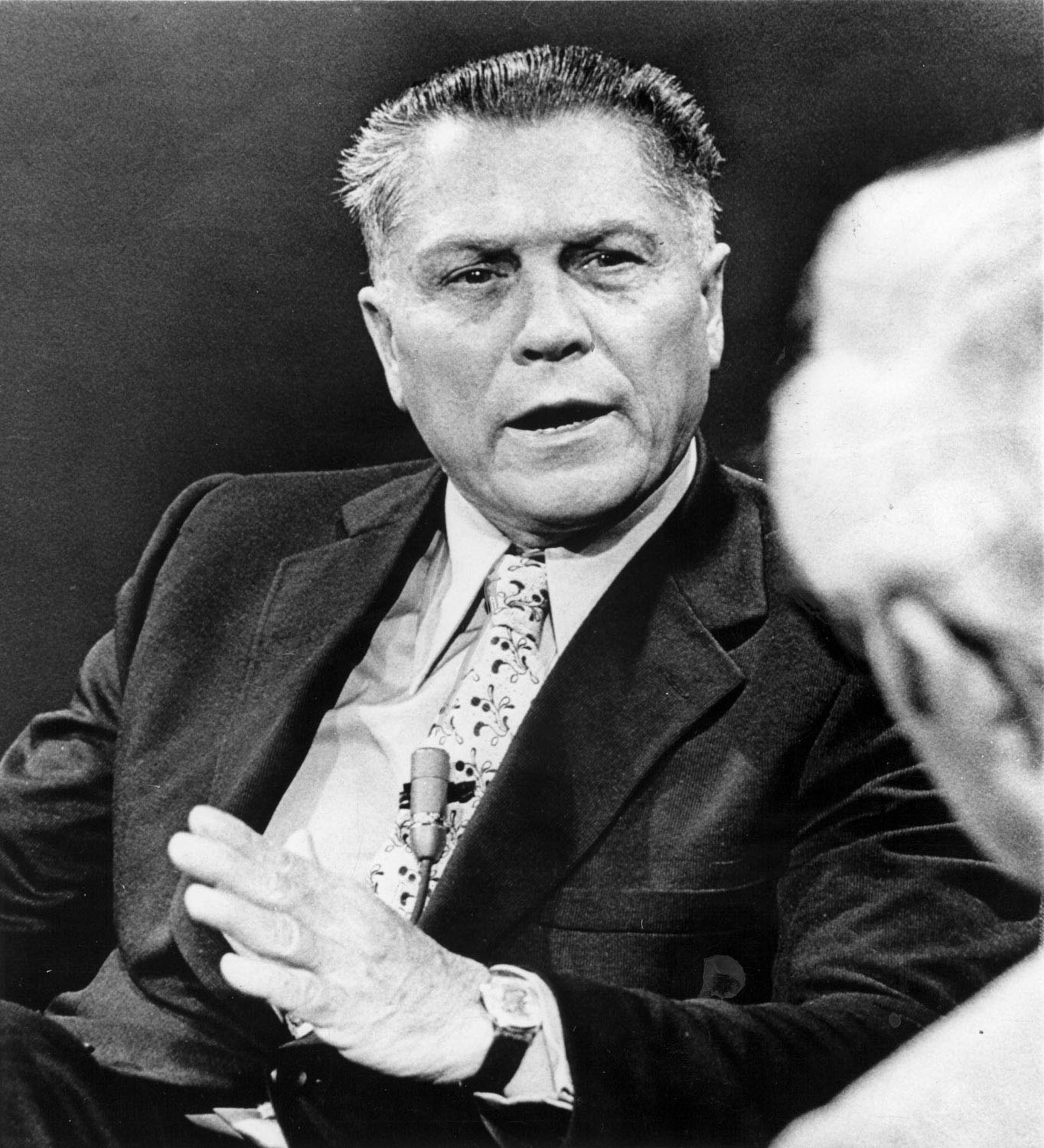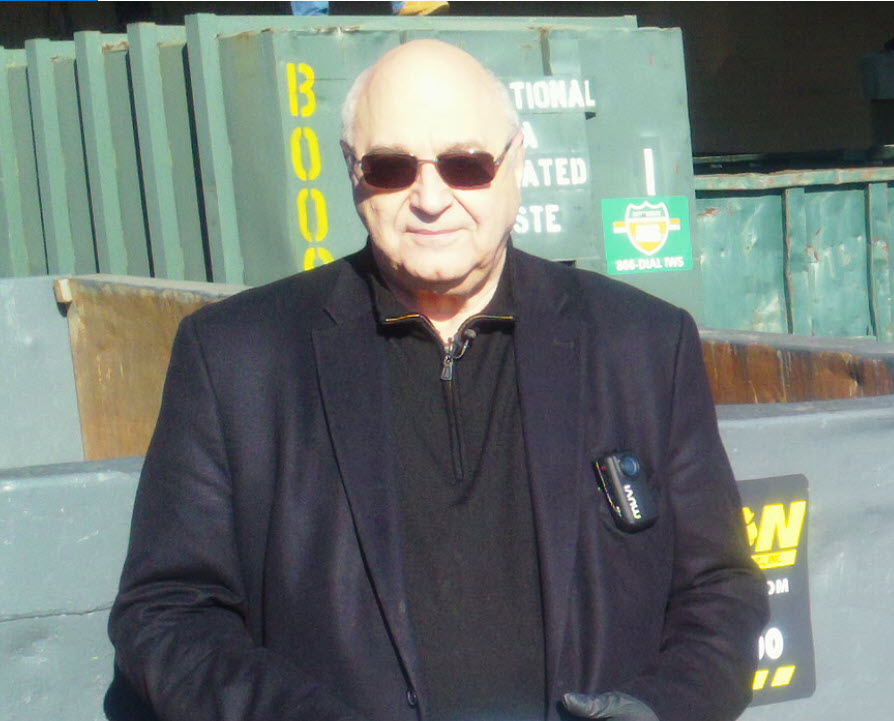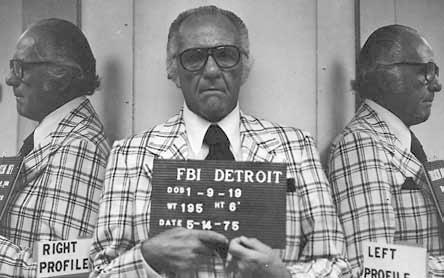Latest search for Jimmy Hoffa’s remains joins long list of fruitless attempts
FBI says it found ‘nothing of evidentiary value’ at New Jersey dump site

The FBI announced in July that it did not find any sign of the body of former Teamsters Union leader James Hoffa after surveying and digging for weeks near a former New Jersey landfill. The news came only days before the 47th anniversary of Hoffa’s disappearance outside Detroit.
“Nothing of evidentiary value was discovered during that search,” Special Agent Mara Schneider, public affairs officer for the bureau’s Detroit field office, said in a prepared statement. “While we do not anticipate any additional activity at the site, the FBI will continue to pursue any viable lead in our efforts to locate Mr. Hoffa.”
Thus, the agency concluded yet another attempt to locate Hoffa’s final resting place, a search that began after he vanished from where he was last seen, a restaurant parking lot in suburban Detroit on July 30, 1975. In November of that year, the FBI, based on a mobster’s tip, looked around the same Jersey City dump site but found nothing.
Since 2000, subsequent explorations had agents digging at a former card casino in Gardena, California; under a suburban swimming pool in Hampton, Michigan; at a farm in Milford, Michigan; a backyard in Roseville, Michigan; the site of a demolished building at a football stadium in New Jersey (on the say-so of a Mob informant); and looking inside a home in Bloomfield, Michigan.
Other less-credible reports, including that Hoffa was stuffed in a barrel and dumped into the Florida everglades (via another Mob squealer) and that his body was melted into steel shipped to Japan, also are part of the Hoffa legend.
Origins of New Jersey search
It was the work of Dan Moldea, investigative journalist and Hoffa expert, that persuaded the FBI to again comb the New Jersey landfill. Moldea remains convinced that Hoffa’s corpse is really there, and that the agency somehow missed it.
His question is whether the FBI examined the exact spot adjacent to the one-time PJP Landfill beneath the Pulaski Skyway overpass. This spot is where Frank Cappola insisted that his father, Paul, the landfill’s Mob-connected co-owner, once showed him where he buried Hoffa in a metal drum shortly after the labor figure went missing.

“Regardless of how this plays out, I still believe that Hoffa is or was buried at or near PJP in Jersey City after his 1975 murder in Detroit . . . and we just can’t find him,” Moldea wrote after the FBI’s announcement on July 21.
Another Hoffa expert offered a different perspective.
“I want Dan to be right; there is no one more on Dan’s side than me,” said Scott Burnstein, an author, Detroit organized crime expert and member of The Mob Museum’s Advisory Council. “I have nothing but respect for Dan.”
Nevertheless, Burnstein trusts that the FBI followed the parameters of the search warrant granted for the New Jersey site. The Detroit-based agents have worked hard for many years for answers and genuinely want to find Hoffa’s remains. The agency, Burnstein said, has spent “tens of millions if not $100 million” over the decades trying to solve the Hoffa whodunit.
“It’s not some case collecting dust. It’s an active case,” he said. “They were going to take this lead at the maximum priority level. There’s pride involved. They’re doing it for the guys who came before them.”
Author committed to landfill story
Moldea, who has written about Hoffa since the mid-1970s, defends his scenario about how and where Hoffa’s body ended up in New Jersey.
Before Frank Cappola’s death in 2020, Moldea had him stand at the precise spot of the purported Hoffa grave and pose for a photo there. Later, Moldea’s crew of civilian investigators and a separate team from Fox News hired companies using ground-penetrating radar (GPR) devices to check for anomalies deep inside the soil. Moldea said both firms found potential evidence that might confirm Frank’s story.
However, the FBI told him that its GPR readings failed to confirm what his and Fox’s readings showed, and so the agency decided not to dig there.
Burnstein does not think the FBI will conduct another search of the New Jersey location. “It would be great for the FBI to entertain going back, but that’s not something they are even considering,” he said. “That’s what I’ve be told.
“I have a hard time believing they have all of this stuff and they would get the warrant for parts of the area and not other parts.”
If it came down to choosing between the private company’s GPRs done for the Moldea and Fox crews and the government’s, Burnstein said, “I’m going to put my money on the government GPR.”
Different theories on Hoffa death
Moldea and Burnstein, who are friends, have different hypotheses about Hoffa’s demise. Their views are theories because the case is still unsolved, and may never be, since virtually everyone with direct knowledge about it is dead.
Moldea recalls that his interest in Hoffa’s Teamsters Union started in December 1974 while a graduate student at age 24. He wrote a newspaper series about the union, which led to research jobs on Hoffa for NBC News and the Wall Street Journal just before the labor boss’s disappearance. Moldea has since been a leading investigative journalist about all things Hoffa. He wrote The Hoffa Wars, published in 1978.
Moldea’s theory that Hoffa was buried near the New Jersey landfill appeared to be promising. The New Jersey idea goes back almost to the start of the Hoffa investigation. In November 1975, several months after Hoffa went missing, the FBI checked out a tip from Ralph Picardo, an associate of New Jersey Mafia capo Anthony “Tony Pro” Provenzano, that Hoffa’s body was buried at the PJP landfill.
As Moldea sees it, Tony Pro contracted Genovese crime family hit man Salvatore Briguglio to kill Hoffa after luring him to a supposed meeting with Provenzano, Detroit Mafia street boss Anthony “Tony Jack” Giacalone and Mob associate Leonard “Little Lenny” Schultz at the Machus Red Fox restaurant in suburban Detroit on the afternoon of July 30, 1975.
Based on Moldea’s many interviews and research, he posits that after Hoffa was murdered, Tony Pro ordered a barrel containing Hoffa’s body transported hundreds of miles from Detroit by truck and delivered to PJP for disposal.
Moldea believes Picardo told the FBI the truth about Hoffa’s burial in the Jersey City site.
While in business, the landfill was nicknamed “Brother Moscato’s Dump,” after the late Phillip “Brother” Moscato, a soldier for New York’s Genovese family who operated it with Paul Cappola.
Moldea reported that Frank Cappola, who submitted to 30 hours of interviews from 2019 to 2020, told him that Moscato ordered Paul Cappola to bury the barrel containing Hoffa’s remains. Cappola said he was 17 years old when a limousine pulled up at PJP with a drum presumably containing Hoffa’s body. He watched as handlers removed the body from the barrel and inserted the corpse head first into a different one.
Frank recounted that his father argued with the people who brought Hoffa’s body. They directed Paul to bury Hoffa in a specific spot at the landfill. But Paul told Frank that, fearing the place was under surveillance by police, he went back at night to a different location just outside the landfill. He used a backhoe to dig a large hole and plunged the Hoffa barrel to the bottom. He dropped a group of up to 15 other barrels over it and covered the whole thing with dirt and debris while leaving a marker somewhere underground.
The area where Paul claims he buried Hoffa is government property, now used as a park and nature preserve.
Burnstein paints a different picture of the murder and disposal of Hoffa’s body. To him, Tony Pro, of New Jersey’s band of the Genovese family, played only a minor role in the conspiracy to eliminate Hoffa. The murder scheme, he said, centered on the Giacalone brothers, Anthony “Tony Jack” and Vito “Billy Jack,” both higher-ups in the Detroit Mafia.
They were happy with the union money kicked back to them by corrupt Teamsters president Frank Fitzsimmons and did not like hearing that Hoffa wanted to run for union president again in 1976, he said. Hoffa had also made certain threats to them, and there were rumors he’d been an FBI informant. Hoffa saw that the only way to return to lead the union was with government backing, and so he might have to run on an anti-corruption platform. To the Giacalones, that jeopardized further payoffs to the Detroit family.

Even though Hoffa and Tony Pro were on bad terms then, Hoffa needed the voting block the mobster held among union members to win election as president. Hoffa, Burnstein said, “was blinded by his obsession to take over the Teamsters” and agreed to a risky meeting with Provenzano, Anthony Giacalone and Schultz.
The theory Burnstein currently favors about Hoffa’s death is that after he entered a car owned by Anthony Giacalone’s son, Hoffa was driven a few miles to a home owned by Carlo Licata, a Detroit Mafia soldier and brother-in-law of Detroit’s acting boss, Giacomo “Black Jack” Tocco. Hoffa had met with the Giacalone brothers there multiple times, so he may not have suspected anything. He was killed in Licata’s home, according to this viewpoint.
The consensus among FBI agents in Detroit, based on wiretaps and informants, is that Hoffa’s killer was local Mafia soldier Anthony “Tony Pal” Palazzolo, Burnstein said.
Hoffa then likely ended up “incinerated, cremated” in one of the nearby sanitation businesses or funeral homes controlled by the Detroit family, he said. The Giacalone brothers, he added, engaged in a “disinformation campaign” from the 1970s to the 2000s to confuse authorities and cover their tracks about Hoffa’s murder.
Burnstein said that to show the lengths the FBI went to find out what happened to Hoffa, they bugged the nursing home in which the 88-year-old Vito Giacalone lived from 2011 to his death in 2012. But they picked up nothing to resolve the ongoing mystery of what happened to Hoffa, and his body.
Feedback or questions? Email blog@themobmuseum.org





